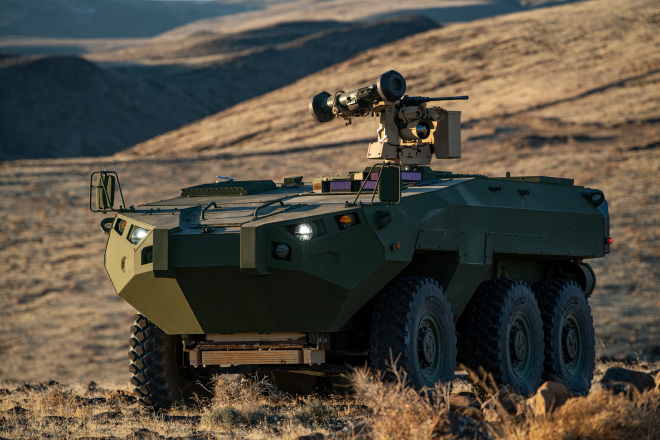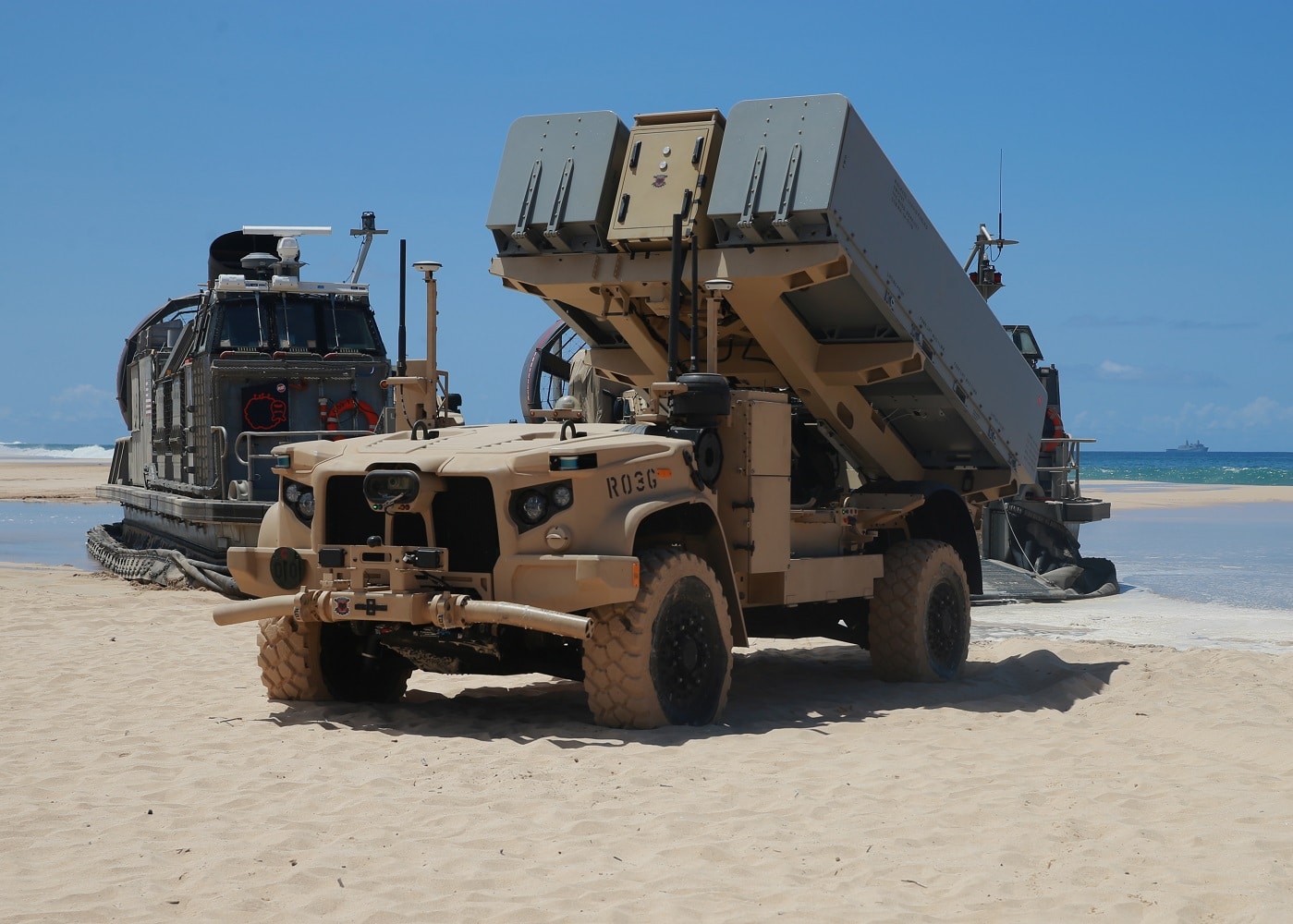Part 2 of 2: Status of Force Design 2030 one year after roll-out
4. US Marine Corps Commandant Gen. David Berger’s decided to implement the CONOPS on Expeditionary Advanced Base Operations (EABO). This EABO concept employs expeditionary systems — emphasizing anti-ship cruise missile launchers — from austere, distributed land bases within adversary weapons engagement zones to contribute sea denial operations. In addition for the U.S. Marines’ Ground Combat Element, as part of Force Design 2030, they have:
- Continued planning for the establishment of three standing Marine Littoral Regiments (MLRs) in III MEF, consisting of an O-6 headquarters, a Littoral Combat Team (LCT), a tailored Combat Logistics Battalion, and a Littoral Anti-Air Battalion.
- Prepared for Infantry Battalion Experiment 2030, which will experiment with one battalion each from 1st, 2nd, and 3d Marine Divisions over the next two years.
- Validated the requirement for Organic Precision Fires – Infantry (OPF-I) to include loitering munitions within our reorganized infantry battalions and LCTs.
- Initiated an enhanced infantry training program to produce more proficient, resilient, and lethal Marine infantry.
- Prepared to divest of 3 AC and 2 RC infantry battalions.
- Completed the divestment of 2 AC and 1 RC tank battalions.
- Continued the planned transition of 14 towed cannon batteries into self-propelled rocket artillery and anti-ship missile batteries.
• Initiated the divestment of two Assault Amphibian (AA) companies.
- Initiated fielding of the Amphibious Combat Vehicle (ACV).
- Identified the likely utility of multi-domain Mobile Reconnaissance units possessing OPF-I, light-weight vehicles, unmanned air and surface systems, boats, and other capabilities necessary to succeed in a contested information environment.
5. The Biden Administration’s Interim National Security Strategic Guidance, in step with SefDec Austin’s recent Letter to the Force continues to identify strategic competition with China as a top priority. To be threat-informed, in the era of great power competition is to understand that not all military capability is conventional.
6. The US Marines have also found a way through MARSOC to adapt to change, in the Indo-Pacific — to converge unconventional warfare with conventional military capability resident in an MEU or MEB for overmatch so that there is no need to even fight in an contested environment (i.e. deter the ‘little green men’ of the enemy), to set up an EABO.
(a) MARSOC was created by fusing the 1st and 2nd Force Reconnaissance Companies with the Marine Special Operations Advisor Group (MSOAG); and MSOAG was originally named the Foreign Military Training Unit (FMTU). The Marine Raider Regiment consists of HQ Company and 3 Marine Raider Battalions (1st, 2d and 3d).
(b) Foreign Internal Defense (FID) operations, security assistance and counter terrorism are critical components of the U.S. National Security Strategy and National Strategy for Counter Terrorism. Thanks to FMTU roots, MARSOC’s flagship core competency is FID, which gives 3 key advantages:
(i) Access.
(ii) Placement.
(iii) Influence.
One way to see it is to say it is THE ability to influence another country because of US access and placement. Another way to put it, is to inject a MARSOC team of guys with guns into a given situation.
(c) But there is more. Their Force Recon background enable the each of these Marine Raider Battalion to conduct direct action, such as, seizing or securing access to a port or air field, when their capabilities need to be aggregated or even operate as part of a coalition. In the 2021 iteration of the Green Dagger exercise (as a lead-in to a larger training event known as Marine Air Ground Task Force Warfighting Exercise 1-22), MARSOC, trained with Royal Marines and the UAE's Presidential Guard to take on another US Marine unit. The invite and active participation of allies like the Royal Commandos, reinforces the strength of NATO relationships and validates the long-held understanding that when the U.S. goes into a fight it does not go alone.
(d) MARSOC can operate disaggregated and has deployed 14-man teams to the Indo-Pacific region on a rotational basis for years, part of a broader effort to support the Filipino military’s struggle with international crime and terrorism. It is highly unlikely T.E. Lawrence (the father of unconventional warfare) would even be admitted to MARSOC selection (3 weeks per phase in 2 phases), let alone pass the current initial training course (9 months long), as it would be too tough. But before a MARSOC company deploys, they undergo Exercise Raven.
7. Not many people within the US Defense Department can deploy to remote parts of the world in small teams and engage with indigenous forces across language and culture barriers. Subsequently, the need for more FID experts was an impetus for the creation of MARSOC.
(a) The Marine Raider Battalions have a key role to play in the 1st and 2nd island chain, where their foreign language skills and ability to blend in help secure the relationship with local forces. A Marine Raider Battalion is intended to be paired with and supported by the III Marine Expeditionary Force during combat operations to increase cost effectiveness, and to provide special reconnaissance — on China’s string of pearls. If the gloves come off, Chinese agents in numerous countries suddenly become fair game.
(b) There are MARSCO operators with a good understanding of both the Chinese language and its culture. They want native language speakers, that understand the nuances of specific parts to a language but also the culture.
(c) The Marine Raider Battalions also have support staff that are assisting in military AI development and in information support operations, in local languages; and it is important to make sure they understand the environment they are working in.
(i) The best thing about MARSOC is that no one outside of SOCOM knows what they do and it should be kept that way. Keeping in mind that they are under SOCOM and their reach is global.
(ii) In July 2021, it was reported that more than 300 SOCOM representatives, including members of senior leadership as well as other, lower-ranked officers and civilians, was sent for a 6 week course to understand broad future trends in AI development, and commercial deployment.
(iii) The discussion included how operators might use tools like computer vision in the near future, “not just to detect vehicles here or there, but try to make sense of the imagery in a conceptual way,” Sertac Karaman, a professor in the Department of Aeronautics and Astronautics at MIT said. Other portions of the course were devoted to AI safety and how to pursue new capabilities while adhering to the Pentagon’s AI ethical principles. SOCOM head Gen. Richard Clarke told lawmakers that one of the key features of the course from a SOCOM perspective was to help senior and mid-tier SOCOM personnel “learn what the AI principles were so that they could ask the right questions.”




